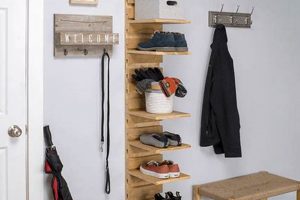A space-saving furniture solution integrates a sleeping platform and a work surface, typically utilizing a folding or retractable mechanism. This dual-purpose design allows for efficient use of limited square footage. As an example, consider a small apartment where the bed folds up against the wall during the day, revealing a desk for work or study.
This type of furniture offers several advantages, including maximizing floor space, promoting organization, and enhancing the functionality of compact living areas. Historically, similar space-saving concepts have been employed in various settings, such as ships and small apartments, to optimize limited resources. The modern iteration benefits from advancements in materials and mechanisms, providing improved durability and ease of use.
The subsequent discussion will address key considerations for constructing this type of furniture, including design principles, material selection, and safety protocols. Furthermore, it will elaborate on specific construction techniques and provide guidance on overcoming common challenges encountered during the creation process.
Construction Considerations
The following provides guidance on crucial aspects during construction. Careful adherence to these points ensures a successful project outcome.
Tip 1: Accurate Measurements are Critical: Precise measurements of the available space and the selected mattress are essential. Errors in dimensions can lead to significant challenges during assembly and operation. Verify all measurements multiple times before commencing cutting or assembly.
Tip 2: Prioritize Robust Hardware Selection: The folding mechanism and supporting hardware bear considerable weight and undergo frequent use. Opt for high-quality, durable hardware specifically designed for folding beds. Examine weight ratings and ensure compatibility with the anticipated load.
Tip 3: Emphasize Structural Integrity: Reinforce all joints and connections with appropriate fasteners and adhesives. Consider incorporating additional bracing to prevent warping or sagging over time. The structural integrity directly impacts the longevity and safety of the completed project.
Tip 4: Integrate a Secure Locking Mechanism: A reliable locking mechanism is crucial to prevent accidental deployment or collapse of the bed. Select a mechanism that is easy to operate yet provides a firm and secure hold. Regularly inspect and maintain the locking system.
Tip 5: Design for Smooth Operation: Ensure that the folding mechanism operates smoothly and effortlessly. Proper alignment and lubrication are essential for minimizing friction and preventing binding. Test the mechanism repeatedly throughout the construction process.
Tip 6: Ensure Adequate Desk Support: The desk portion must be adequately supported, whether in the open or closed bed configuration. Consider using sturdy legs, folding supports, or a combination thereof to prevent instability and ensure a level work surface.
The diligent implementation of these recommendations contributes significantly to the creation of a safe, functional, and long-lasting space-saving furniture solution. Proper execution of these tips minimizes risks and ensures the final product meets expectations.
The subsequent section will address aesthetic considerations and explore options for customizing the finished product to complement existing interior design.
1. Space Optimization
The inherent design of the specified furniture directly addresses the need for space optimization, particularly in confined living environments. The dual functionality, combining a sleeping area and a work surface, facilitates efficient utilization of available square footage. The primary mechanism, a folding or retractable bed, enables the transformation of a room from a bedroom to a workspace in a matter of moments. This transformative capability is particularly beneficial in studio apartments, small homes, or multi-purpose rooms where space is at a premium. The consequences of inadequate space optimization in such settings include clutter, reduced functionality, and an overall diminished quality of life. A properly executed example allows a small room to serve as a bedroom at night and a home office during the day, thereby significantly increasing the utility of the space.
Beyond the basic functionality, strategic design considerations further enhance space optimization. Integrating storage solutions, such as shelves or drawers, into the surrounding cabinet structure can maximize vertical space and reduce the need for additional furniture. Furthermore, the desk component can be designed to accommodate storage needs, such as built-in drawers or a concealed cable management system. The effective integration of these features contributes to a more organized and clutter-free environment. For example, a desk with integrated shelving can house books, office supplies, and decorative items, reducing the reliance on separate shelving units and freeing up floor space. This level of integration significantly amplifies the benefits of the initial space-saving concept.
In summary, space optimization is not merely a desirable attribute but a fundamental design principle of the specified furniture. Its successful implementation directly impacts the usability and overall value of the furniture, transforming confined spaces into functional and adaptable living areas. Failure to prioritize space optimization can undermine the entire project, resulting in a bulky and inefficient piece of furniture that fails to achieve its intended purpose. Understanding this connection is paramount for maximizing the benefits and ensuring a successful outcome.
2. Mechanism Reliability
Mechanism reliability is paramount for the safe and consistent operation of any space-saving furniture that integrates a folding or retractable bed and a desk. The long-term usability and safety of this furniture are intrinsically linked to the dependability of its mechanical components.
- Hardware Durability
The selection of robust and durable hardware is fundamental to mechanism reliability. Hinges, springs, pistons, and locking mechanisms must withstand repeated stress and weight. Inferior components are prone to failure, leading to operational difficulties, potential injuries, and a shortened lifespan of the furniture. Consider the stress from a real-world scenario: a bed used daily by a heavier individual places significantly more strain on the hardware than occasional use by a lighter person. Therefore, selecting hardware with appropriate weight ratings and demonstrated durability is essential.
- Smooth Operation
A reliable mechanism facilitates smooth and effortless operation. Binding, sticking, or jerky movements indicate potential issues with alignment, lubrication, or component quality. Smooth operation minimizes stress on the mechanism and reduces the likelihood of premature wear and tear. Regular maintenance, including lubrication and inspection of moving parts, contributes to maintaining smooth operation over time. Examples of problems include squeaking hinges that indicate a lack of lubrication or scraping noises that signify misalignment.
- Locking Security
A secure locking mechanism is crucial for preventing accidental deployment or collapse of the bed. The locking system must be reliable and easy to engage and disengage, yet provide a firm and secure hold when the bed is in its upright or horizontal position. Failure of the locking mechanism can result in serious injury. Real-world concerns include children playing near the furniture or inadvertent bumping of the unit, which could trigger an uncontrolled release if the locking mechanism is compromised.
- Structural Integration
Mechanism reliability is not solely dependent on the individual components but also on their integration within the overall structure. The framework supporting the mechanism must be robust and properly aligned to distribute weight evenly and prevent undue stress on specific points. Weak or improperly constructed supports can lead to premature failure of the mechanism, even if the individual components are of high quality. The attachment points of the mechanism to the surrounding structure are critical areas that require careful attention to ensure secure and stable connections.
In conclusion, mechanism reliability is a critical factor influencing the long-term functionality and safety of a DIY folding bed with integrated desk. Paying close attention to hardware durability, smooth operation, locking security, and structural integration is essential for creating a reliable and safe furniture solution. Overlooking these aspects can result in a product that is both impractical and potentially dangerous.
3. Material Selection
Material selection exerts a significant influence on the structural integrity, functionality, and aesthetic appeal of any furniture project, particularly one as complex as a wall bed with an integrated desk. The choice of materials directly affects the furniture’s ability to withstand weight, resist wear and tear, and maintain its form over time. Furthermore, materials influence the ease of construction, the overall cost, and the final aesthetic appearance of the unit. For instance, using solid hardwood for the frame provides superior strength and durability compared to particleboard, but it also increases the cost and complexity of the project. In contrast, utilizing lightweight materials for the folding bed components can reduce strain on the lifting mechanism, but may compromise the bed’s ability to support heavier loads.
Specific considerations for material selection include the frame, the bed platform, the desk surface, and the hardware attachments. The frame, which bears the brunt of the weight, often benefits from the use of hardwoods like oak or maple, or alternatively, high-quality plywood with sufficient thickness and bracing. The bed platform must be constructed to minimize sagging and maximize support, often requiring a combination of solid wood slats and a rigid frame. The desk surface needs to be durable and scratch-resistant, with options ranging from solid wood to laminate or veneer over a stable core. Hardware attachments, such as hinges and screws, should be chosen based on their load-bearing capacity and resistance to corrosion. A real-world example illustrating the importance of material selection involves a project where particleboard was used for the frame of a wall bed. Over time, the particleboard sagged and eventually failed, rendering the bed unusable and posing a safety hazard. This scenario highlights the necessity of carefully considering the structural requirements and selecting appropriate materials.
In summary, material selection is not merely a cosmetic decision but a critical engineering consideration in the creation of a wall bed with a desk. The chosen materials directly impact the furniture’s structural integrity, functionality, longevity, and safety. By carefully evaluating the trade-offs between cost, weight, strength, and aesthetic appeal, the project can be optimized for its intended use and long-term durability. A failure to adequately consider material selection can result in a structurally unsound and potentially dangerous piece of furniture, undermining the entire project.
4. Desk Integration
The incorporation of a desk into a wall bed design represents a significant enhancement in space utilization, transforming a single-purpose sleeping area into a multifunctional living space. The integration process necessitates careful consideration of design, mechanics, and user ergonomics to ensure seamless transition between functionalities and optimal user experience.
- Spatial Harmony
The desk must integrate harmoniously within the overall structure when the bed is both deployed and stowed. This requires precise measurements and thoughtful design to prevent interference between the desk and bed components. For instance, a desk that is too deep may obstruct the bed’s folding mechanism, while one that is too shallow may provide inadequate workspace. The desk’s dimensions must be carefully calculated to maximize usable area without compromising the functionality of the bed. Examples include fold-down desks that remain level during bed operation or sliding desks that retract beneath the bed when stowed.
- Ergonomic Considerations
The desk’s height and depth must conform to ergonomic standards to promote comfortable and efficient work. A desk that is too high or too low can lead to discomfort and potential strain injuries. The desk should provide sufficient legroom and allow for comfortable placement of a chair. Furthermore, the desk surface should be adequately sized to accommodate a computer, keyboard, and other necessary work materials. Adjustable-height desks provide greater flexibility to accommodate individual user preferences and promote better posture. A poorly designed desk can discourage use, negating the intended benefits of the space-saving furniture.
- Structural Support
The desk component requires adequate structural support to withstand the weight of work materials and prevent sagging or instability. This support can be achieved through sturdy legs, reinforced framing, or a combination of both. The support system must be integrated into the overall structure to ensure that the desk remains stable regardless of the bed’s position. Insufficient support can lead to desk failure, posing a safety hazard and rendering the workspace unusable. For example, a desk surface constructed of thin plywood without adequate bracing may bow under the weight of a computer and books.
- Cable Management
Integrating cable management solutions into the desk design promotes a tidy and organized workspace. This can involve incorporating grommets, channels, or trays to conceal and organize cables from computers, monitors, and other electronic devices. Effective cable management reduces clutter, improves aesthetics, and prevents cables from becoming tangled or damaged. Poor cable management can create a visually unappealing workspace and pose a tripping hazard. The design should accommodate the user’s anticipated technological needs, including provisions for power outlets and network connectivity.
These four elements spatial harmony, ergonomic considerations, structural support, and cable management collectively determine the success of desk integration within a DIY wall bed project. Proper execution results in a functional and aesthetically pleasing workspace that seamlessly complements the space-saving benefits of the folding bed. Inadequate attention to these details can lead to a compromised design, rendering the desk impractical, uncomfortable, or even unsafe.
5. Safety Latches
Safety latches are a non-negotiable component within the design and construction of any wall bed, particularly those undertaken as do-it-yourself projects integrating a desk. These mechanisms are the primary safeguard against unintended deployment of the bed, preventing potential injury or damage.
- Primary Prevention of Uncontrolled Descent
Safety latches act as the first line of defense against gravity. The inherent weight of a wall bed presents a significant hazard if the supporting mechanism fails or is inadvertently released. A properly functioning safety latch physically secures the bed frame in the upright, stowed position, mitigating the risk of a sudden and uncontrolled descent. Consider a scenario where a spring-loaded mechanism weakens over time: without a reliable safety latch, the bed could unexpectedly drop, causing serious injury to anyone in its path. The latch prevents this occurrence.
- Redundancy in Mechanical Systems
Even with robust lifting mechanisms and counterbalance systems, safety latches provide essential redundancy. Mechanical components are subject to wear, fatigue, and potential failure. The safety latch acts as a failsafe, engaging independently of the primary lifting mechanism. This redundancy provides an added layer of security, ensuring that the bed remains securely stowed even if the lifting mechanism malfunctions. An example would be if a hydraulic piston loses pressure: the safety latch would prevent the bed from falling.
- User-Initiated Engagement and Disengagement
Effective safety latches require deliberate action from the user to engage and disengage. This prevents accidental release due to bumping, jarring, or the actions of children. The latching mechanism should be designed for ease of use while simultaneously requiring a conscious effort to operate. Clear visual indicators, such as color-coded levers or markings, can further enhance user awareness of the latch’s status. An example of a good design would be a two-handed latch requiring simultaneous action, making accidental release less likely.
- Material Strength and Load Capacity
The materials used in the construction of safety latches must possess adequate strength and load capacity to withstand the forces generated by the weight of the bed. The latching components, including the locking pin, receiver, and associated hardware, must be fabricated from high-quality steel or other durable materials. The design should account for dynamic loads, such as the sudden impact of the bed shifting, as well as static loads sustained over extended periods. An example would be using hardened steel for the locking pin to prevent deformation under stress.
The integration of robust and reliable safety latches is not merely an optional feature but an essential requirement for all DIY wall bed with desk projects. Prioritizing safety in design and construction ensures user well-being and mitigates the potential for serious accidents. Without properly functioning safety latches, the inherent risks associated with wall beds are significantly amplified, rendering the furniture a potential hazard.
6. Aesthetic Cohesion
The pursuit of aesthetic cohesion in the context of constructing space-saving furniture transcends mere decorative considerations. Instead, it entails a holistic integration of design elements, ensuring that the completed unit harmonizes seamlessly with its surrounding environment, both visually and functionally. This process demands careful attention to detail, from the selection of materials and finishes to the incorporation of complementary design motifs.
- Material Palette Harmony
The selected materials, including wood species, laminates, and hardware finishes, must complement existing dcor. An incongruent material palette can disrupt the visual flow of the room and create a jarring aesthetic effect. For instance, a modern, minimalist room featuring sleek, metallic accents would clash with a wall bed constructed from rustic, knotty pine. Conversely, a room with warm, earthy tones would benefit from a wall bed crafted from similar materials. The careful coordination of material choices ensures a unified and visually pleasing design. Real-world implications include considering existing flooring, wall colors, and furniture styles when selecting materials for the wall bed.
- Architectural Style Integration
The design of the wall bed should align with the architectural style of the room or building. A contemporary loft with exposed brick and concrete floors would necessitate a different design approach compared to a traditional Victorian home with ornate moldings and period details. The wall bed’s design should incorporate elements that complement the existing architectural features, such as matching trim profiles or incorporating similar design motifs. For instance, in a mid-century modern home, a wall bed with clean lines, minimalist hardware, and walnut veneer would seamlessly integrate with the existing aesthetic. Failure to consider architectural style can result in a piece of furniture that feels out of place and disrupts the overall visual harmony.
- Scale and Proportion Considerations
The dimensions and proportions of the wall bed must be carefully considered in relation to the size of the room and the surrounding furniture. A wall bed that is too large can overwhelm the space and create a feeling of claustrophobia, while one that is too small may appear insignificant and fail to make a visual impact. The proportions of the desk component should also be carefully considered to ensure that it is ergonomically sound and visually balanced. A real-world example would be a small studio apartment where a full-size wall bed with a large desk would dominate the room, making it feel cramped and uncomfortable. In such a space, a smaller, more compact unit with a fold-down desk would be a more appropriate choice.
- Hardware and Detailing Consistency
The selection of hardware, such as handles, knobs, and hinges, should be consistent with the overall design aesthetic. The style, finish, and size of the hardware should complement the materials and architectural style of the room. Inconsistent or mismatched hardware can detract from the overall visual appeal and create a sense of disunity. Furthermore, the detailing of the wall bed, such as the design of the cabinet doors, the trim profiles, and the placement of decorative elements, should be carefully considered to ensure that it aligns with the overall aesthetic vision. Consistent hardware and detailing contribute to a cohesive and polished final product.
The pursuit of aesthetic cohesion in the creation of a DIY wall bed with desk is not merely a superficial exercise but a fundamental aspect of successful integration into the living space. By carefully considering material palette harmony, architectural style integration, scale and proportion considerations, and hardware and detailing consistency, a cohesive and visually appealing unit can be achieved, enhancing both the functionality and the aesthetic value of the living environment.
Frequently Asked Questions
The following addresses common inquiries concerning the design, construction, and practical considerations related to building a space-saving bed and desk combination.
Question 1: What are the essential safety precautions to observe during the construction of a wall bed?
Construction requires adherence to established safety protocols. Wear appropriate personal protective equipment, including eye protection and respiratory masks when cutting or sanding materials. Securely clamp workpieces to prevent movement during cutting or drilling operations. Ensure adequate ventilation when using adhesives or finishes that emit fumes. Adherence to these guidelines minimizes the risk of injury.
Question 2: How critical is the selection of hardware, specifically hinges and locking mechanisms?
Hardware selection is of paramount importance. Hinges and locking mechanisms must be rated to withstand the considerable weight and stress associated with repeated opening and closing cycles. Inferior hardware can lead to premature failure, posing a significant safety risk. Verify the weight ratings and material composition of all hardware components prior to installation.
Question 3: What type of mattress is most suitable for a wall bed?
Mattress selection requires consideration of both thickness and weight. Excessive thickness can impede the folding mechanism, while excessive weight places undue stress on the supporting hardware. Opt for a mattress specifically designed for wall beds, characterized by a moderate thickness and relatively light weight. Memory foam or latex mattresses are often suitable choices.
Question 4: How do I ensure the structural integrity of the desk component, particularly when the bed is deployed?
Desk structural integrity is maintained through robust support mechanisms. Employ sturdy legs, folding supports, or a combination thereof. Ensure that these supports are securely fastened to both the desk surface and the surrounding frame. Reinforce joints with appropriate fasteners and adhesives to prevent sagging or instability. Routine inspection is recommended to identify any signs of weakening.
Question 5: What are the primary considerations when optimizing space utilization in a small room?
Space optimization mandates careful planning. Minimize clutter by incorporating integrated storage solutions, such as shelves and drawers, into the design. Maximize vertical space by utilizing tall cabinets or shelving units. Select a desk design that minimizes its footprint when not in use, such as a fold-down or pull-out model. Thoughtful planning is crucial for efficient space management.
Question 6: How can the aesthetic design be integrated to harmonize with existing room decor?
Aesthetic integration demands careful coordination of materials, finishes, and design elements. Select materials and finishes that complement the existing color palette and architectural style of the room. Incorporate design motifs that echo existing patterns or textures. Pay attention to the details, such as hardware selection and trim profiles, to ensure a cohesive and visually appealing result.
Diligent consideration of these inquiries promotes a safer and more effective furniture creation process. Proper adherence to these aspects mitigates risks and enhances the final product’s value.
Subsequent sections will explore specific design modifications, offering various approaches to the construction of such furniture.
Conclusion
This exploration of the do-it-yourself space-saving furniture solution has examined the multifaceted considerations inherent in its design and construction. Emphasis has been placed on safety, structural integrity, material selection, space optimization, and aesthetic integration. The discussion encompassed critical aspects ranging from the selection of robust hardware and reliable locking mechanisms to the ergonomic design of the integrated desk and the harmonious blending of the unit with existing dcor.
The effective implementation of these principles requires meticulous planning and diligent execution. The decision to undertake such a project necessitates a thorough assessment of individual skill sets and a commitment to adhering to established safety protocols. Those embarking on this endeavor should prioritize safety above all else, ensuring that the completed furniture meets the functional needs of the space and offers long-term value.







